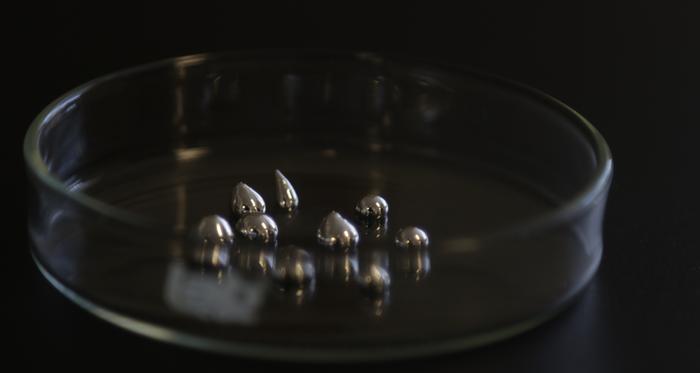Liquid Metal: A Transformative Material for Nanotechnology Applications
What is Liquid Metal?
Liquid metal refers to a class of metallic materials that remain in a liquid state at or near room temperature. These materials possess unique properties, such as high electrical and thermal conductivity, low vapor pressure, and the ability to deform and flow like a liquid while retaining metallic characteristics. The most commonly studied liquid metals include gallium, indium, tin, and their alloys, such as eutectic gallium-indium (EGaIn) and gallium-indium-tin (Galinstan).

Properties of Liquid Metals
Liquid metals possess a unique combination of properties that make them attractive for various nanotechnology applications:
- Fluidity: Liquid metals can flow and deform like a liquid, enabling them to conform to various shapes and fill intricate spaces. This fluidity allows for the creation of flexible and stretchable electronic devices and the development of self-healing materials.
- High Conductivity: Liquid metals exhibit excellent electrical and thermal conductivity, surpassing that of many solid metals. This high conductivity enables efficient heat dissipation and the creation of highly conductive electronic circuits and interconnects.
- Low Toxicity: Many liquid metals, such as gallium and its alloys, have low toxicity compared to mercury, making them safer for use in biomedical applications and consumer products.
- Self-Healing: Liquid metals can self-heal and reform after being subjected to mechanical damage or deformation. This self-healing property allows for the development of resilient and durable electronic devices and structures.
Synthesis and Processing of Liquid Metals
Liquid metals can be synthesized and processed using various techniques, depending on the desired application and the specific liquid metal composition:
- Alloying: Liquid metal alloys, such as EGaIn and Galinstan, are typically prepared by mixing the constituent metals in the appropriate ratios and heating them above their melting points. The resulting alloy remains liquid at room temperature.
- 3D Printing: Liquid metals can be 3D printed using direct-write or inkjet printing techniques. These methods allow for the fabrication of complex liquid metal structures and circuits with high resolution and precision.
- Microfluidic Manipulation: Liquid metals can be manipulated and patterned using microfluidic techniques, such as flow focusing and channel confinement. These techniques enable the creation of liquid metal droplets, wires, and patterns with controlled sizes and shapes.
- Surface Modification: The surface properties of liquid metals can be modified through the use of coatings, such as oxides or polymers, to enhance their stability, wettability, and compatibility with other materials.
Applications of Liquid Metals
Liquid metals have found numerous applications in nanotechnology, leveraging their unique properties and processability:
Flexible and Stretchable Electronics
Liquid metals can be used as conductive inks or embedded in elastomeric substrates to create flexible and stretchable electronic devices, such as sensors, antennas, and interconnects. The fluidity and self-healing properties of liquid metals enable the creation of electronics that can withstand repeated deformation and mechanical stress.
Soft Robotics
Liquid metals can be used as soft and deformable actuators and sensors in soft robotic systems. By injecting liquid metal into soft elastomeric channels or structures, it is possible to create flexible and compliant robotic components that can adapt to their environment and perform complex motions.
Thermal Management
The high thermal conductivity of liquid metals makes them attractive for thermal management applications in electronics and energy systems. Liquid metal-based heat spreaders, heat sinks, and thermal interface materials can efficiently dissipate heat from high-power electronic devices and improve their performance and reliability.
Biomedical Applications
Liquid metals have shown promise in various biomedical applications, such as drug delivery, biosensing, and tissue engineering. The low toxicity and fluidic nature of liquid metals enable their use as injectable electrodes, biosensors, and drug delivery vehicles. Additionally, liquid metal-based scaffolds can be used for the regeneration and repair of tissues and organs.
Challenges and Future Perspectives
While liquid metals offer exciting opportunities for nanotechnology applications, several challenges need to be addressed. One of the main challenges is the oxidation and corrosion of liquid metals in air or aqueous environments, which can affect their stability and performance. Strategies such as surface passivation and encapsulation are being developed to mitigate these issues.
Future research in liquid metal nanotechnology will focus on the development of advanced liquid metal composites and hybrids with enhanced properties and functionalities. The integration of liquid metals with other nanomaterials, such as nanoparticles, nanowires, and 2D materials, will enable the creation of multifunctional and responsive systems. Additionally, the exploration of liquid metals for energy storage and conversion applications, such as batteries and thermoelectric devices, will be a key area of investigation.
Further Reading
Chemistry Open, Recent Development in Liquid Metal Materials
Journal of Polymer Science, Multifunctional liquid metal polymer composites
Advanced Materials, Stretchable and Soft Electronics using Liquid Metals
Chemical Society Reviews, Liquid metals: fundamentals and applications in chemistry
